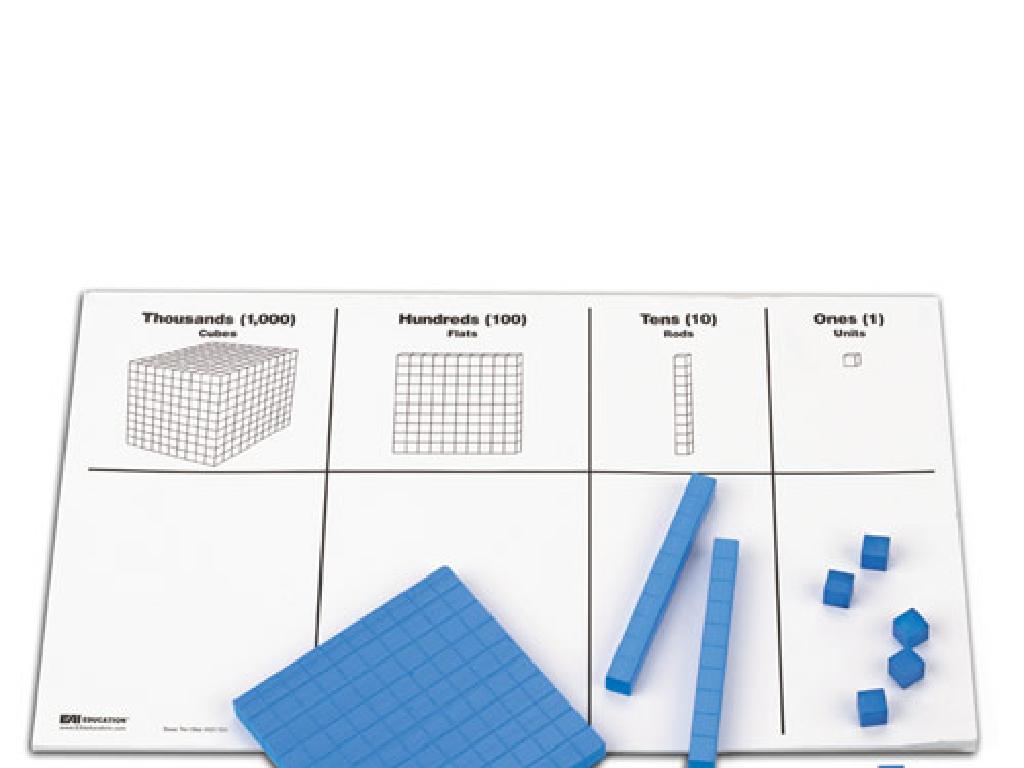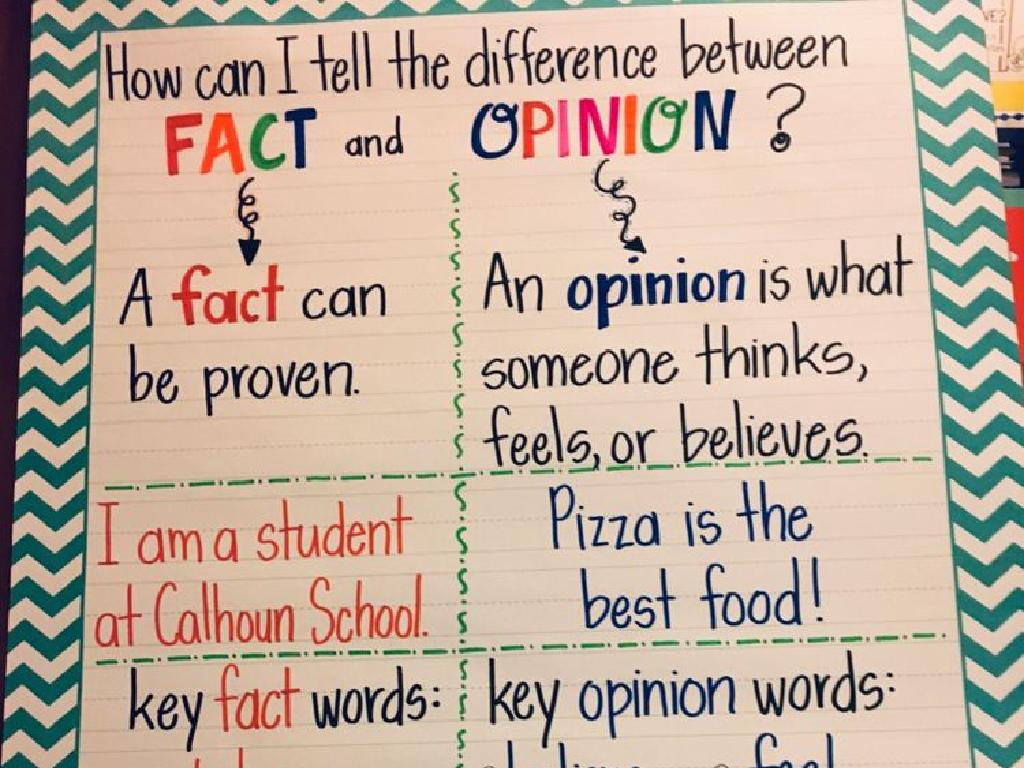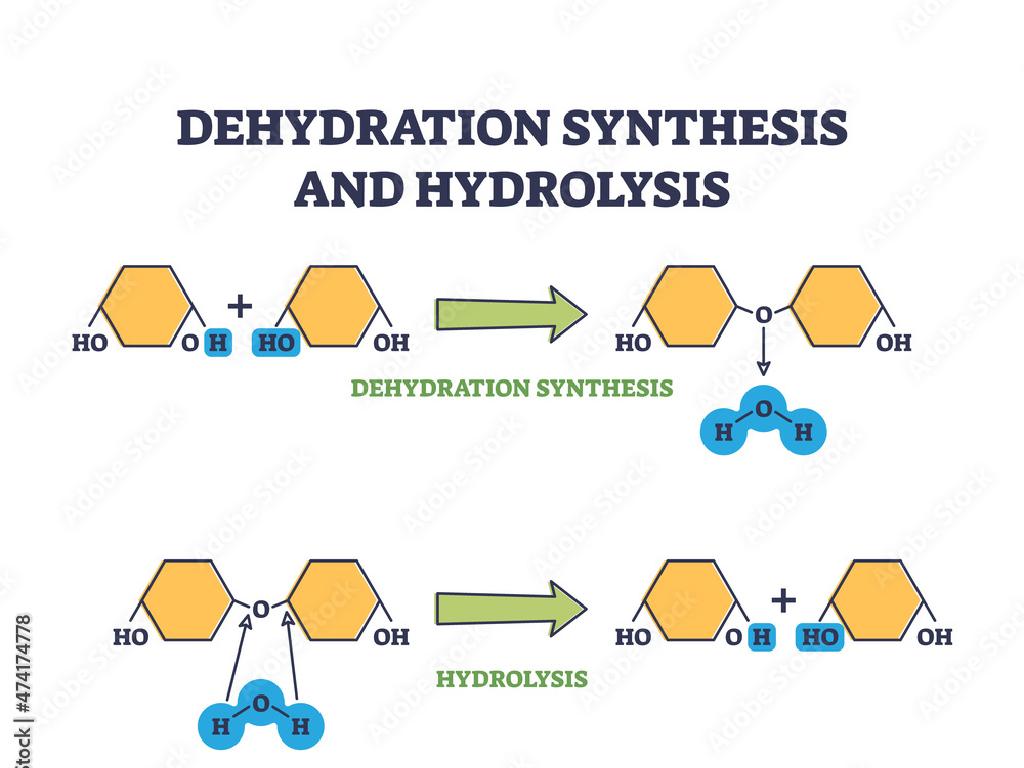Area
Subject: Math
Grade: Eighth grade
Topic: Perimeter And Area
Please LOG IN to download the presentation. Access is available to registered users only.
View More Content
Welcome to Area Exploration!
– Understanding Area: Space Inside
– Area measures the space within a 2D shape, like squares on a grid.
– Importance of learning about area
– Knowing area is essential for resource allocation, construction, and design.
– Area’s real-life applications
– Used in farming, architecture, interior design, and more.
– Calculating area: formulas & units
– Use length x width for rectangles/squares, and other formulas for different shapes.
|
This slide introduces the concept of area as a fundamental aspect of geometry, emphasizing its importance in both theoretical and practical contexts. Students should understand that area represents the amount of two-dimensional space inside a boundary and is measured in square units. Highlight the significance of area in real-world scenarios such as planning living spaces, creating art, or allocating land for agricultural use. Encourage students to think about how they encounter the concept of area in their daily lives. The slide also sets the stage for learning how to calculate the area of various shapes using appropriate formulas, which is a critical skill in many fields, including science, engineering, and the arts.
Recap: Understanding Perimeter
– Review perimeter concepts
– Perimeter is the total distance around a shape
– Differentiate perimeter and area
– Perimeter is the outline; area is the space inside
– Calculate perimeter examples
– Add all side lengths for shapes like rectangles
– Perimeter in various shapes
– Consider different units: cm, m, inches
|
Begin with a quick review of what perimeter means, emphasizing that it’s the total distance around the edge of a two-dimensional shape. Clarify the difference between perimeter and area, ensuring students understand that perimeter refers to the length of the outline of a shape, while area measures the space contained within it. Provide examples of how to calculate the perimeter of common shapes such as rectangles and squares by adding the lengths of all sides. Highlight the importance of consistent units when measuring and calculating perimeter. Encourage students to think about perimeter in the context of real-life scenarios, such as fencing a garden or framing a picture.
Understanding the Concept of Area
– Area defined in mathematics
– The amount of space inside a 2D shape
– Area measured in square units
– Units like square meters (m²), square feet (ft²)
– Counting area on grid paper
– Use grid paper to count the squares inside a shape
– Practical application of area
|
Begin the lesson by defining area as the measure of space within the boundaries of a two-dimensional shape. Explain that area is always measured in square units, which could be square meters, square feet, etc., depending on the measurement system in use. Demonstrate how to calculate the area of a shape by counting the number of square units it covers on grid paper. This visual method helps students grasp the concept of area concretely. Emphasize the importance of understanding area in real-world contexts, such as determining the amount of paint needed for a wall or the size of carpeting for a room. Encourage students to practice with different shapes on grid paper to solidify their understanding.
Calculating Area: Rectangles and Squares
– Area formula for a rectangle
A = length × width, where A is area
– Rectangle area practice problem
Find the area of a 5m x 3m rectangle
– Area formula for a square
A = side × side, where A is area
– Square area practice problem
Find the area of a square with 4m sides
|
This slide introduces the formulas for calculating the area of rectangles and squares, fundamental concepts in geometry. Start by explaining that the area represents the space inside a two-dimensional shape. For rectangles, the area is found by multiplying the length by the width. Provide a practice problem, such as finding the area of a rectangle with given dimensions. Then, move on to squares, where each side is equal, and the area is the side length squared. Offer a practice problem for squares as well. Encourage students to solve these problems and understand how these formulas are derived and applied. This will solidify their grasp of area calculation and prepare them for more complex shapes.
Calculating Area: Triangles
– Triangle area formula: A = 1/2 × base × height
– Understanding the 1/2 in the formula
– The 1/2 accounts for the triangle being half of a rectangle
– Practice problem: Calculate a triangle’s area
– Given a triangle with base 10 cm and height 5 cm, find the area
|
Introduce the formula for calculating the area of a triangle and emphasize the multiplication of the base and height. Explain that the factor of 1/2 is used because a triangle can be considered as half of a parallelogram. Provide a practice problem for students to apply the formula, such as finding the area of a triangle with a base of 10 cm and a height of 5 cm. The solution would be A = 1/2 × 10 cm × 5 cm = 25 cm². Encourage students to solve the problem and explain their reasoning. This exercise will help solidify their understanding of the area calculation for triangles.
Calculating Area: Complex Shapes
– Break down complex shapes
– Divide shapes into rectangles, triangles, etc.
– Add and subtract areas
– Sum areas of simple shapes, subtract any overlaps
– Practice problem example
– Find the area of a shape composed of a rectangle and a triangle
– Strategies for complex shapes
|
This slide introduces the concept of calculating the area of complex shapes by breaking them down into simpler, more manageable components. Start by explaining how complex shapes can be divided into a combination of rectangles, triangles, circles, etc. Then, demonstrate how to calculate the area of each simple shape and combine these areas adding for combined spaces and subtracting for any overlapping parts. Use a practice problem to apply these concepts, such as finding the area of a shape that includes both a rectangle and a triangle. Encourage students to identify the base and height of each simple shape and to use the appropriate area formulas. This methodical approach simplifies the process and equips students with problem-solving strategies for dealing with complex geometric figures.
Area in the Real World
– Professionals using area
– Architects design buildings, farmers plan crop space
– Garden area calculation activity
– Measure length and width, then calculate
– Importance of accurate measurements
– Small errors can lead to big problems
|
This slide aims to connect the concept of area with its practical applications in various professions. For instance, architects use area to design spaces efficiently, while farmers need to calculate the area for planting crops. The class activity involves students calculating the area for a hypothetical garden, which reinforces the importance of precision in measurements. Accurate measurements are essential because even minor mistakes can result in significant issues, such as insufficient materials or space. Encourage students to think critically about the implications of accuracy in real-world scenarios. Provide them with different scenarios where calculating area is crucial, and discuss the potential outcomes of incorrect calculations.
Class Activity: Area Scavenger Hunt
– Find objects to measure
– Calculate each object’s area
– Use length x width for rectangles/squares
– Record your findings
– Include object, measurements, and area
– Present to the class
|
This interactive activity is designed to help students apply their knowledge of calculating area in a fun and engaging way. Students will search for various objects within the classroom or school that have a measurable area. They should use appropriate formulas for different shapes, such as length times width for rectangles. Encourage them to record the object’s name, the measurements they took, and the calculated area. After the scavenger hunt, students will present their findings to the class, explaining how they calculated the area for each object. This will reinforce their understanding and allow for peer learning. Possible objects to measure could include a book cover, a desktop, a piece of paper, or a whiteboard. Ensure that students are clear on the units of measurement and remind them to include these in their presentations.
Wrapping Up: Area and Practice
– Recap of area concepts
Reviewed how to calculate area for various shapes.
– Homework: Area worksheet
Complete the provided worksheet on different shapes’ areas.
– Practice is key to mastery
Consistent practice will solidify your understanding.
– Keep exploring shapes!
|
As we conclude today’s lesson on area, remind students of the importance of understanding how to calculate the area for different shapes, which is crucial for their mathematical development. For homework, they should complete the worksheet that includes problems on calculating the area of squares, rectangles, triangles, and circles. Emphasize that practicing these calculations will help them become more confident in their skills. Encourage them to try finding areas of objects around them for extra practice. In the next class, we’ll review the homework answers and clarify any doubts, ensuring that everyone is on the same page.






